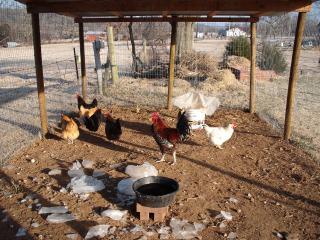- Nov 6, 2010
- 24
- 0
- 22
We are getting a few young layers ("18-24" weeks) tomorrow evening. Our hen house is almost 17 sq feet, the coop about 45. We live in the midwest.
This is our first experience with having our own chickens, I have a 3 year old and soon to be 2 year old who are afraid of any kind of animal except our yellow lab.

Is it a bad idea to put a SLW with a light brahma and a buff?
Should we cover the coop floor with pine shavings, or wait until spring?
Should there be a feeder and a waterer in and outside of the hen house?
Is it bad if the feeders are in front of the nest boxes?
Will three chickens be warm enough or should we get four or even five (which I've read would be okay if they are docile birds)
Since this is our first time I thought having a variety of birds would be fun, to see which ones we like.
However I want a very happy, very calm little flock. Is this most likely to be achieved by getting all of the same breed?
My fear is opening the coop and having a hen burst through the door scaring my little boys to death. Pecking is also worrying me?
From things I've read it seems like SLW tend to be the friendliest when they are among other SLW. If I only get one will it pick the other two to pieces?
I've read that Brahmas do best on sand floors and pine shavings, which is it?
As you can tell I'm a bit scatter brained this morning. But mostly I just want to know what the best combo of chickens is for our coop size?
all the same - in which case I think I would get Bramhas
two of each - two brahmas two buffs
one of each - SLW, brahma, buff, (maybe a barred rock, or a second brahma or buff)
Is is bad two have two of one breed and single of the others?
One more thing, our chickens for the most part will remain in the coop.
Any insights would be greatly appreciated.
Sincerely,
A new ruffled feathered mom

This is our first experience with having our own chickens, I have a 3 year old and soon to be 2 year old who are afraid of any kind of animal except our yellow lab.

Is it a bad idea to put a SLW with a light brahma and a buff?
Should we cover the coop floor with pine shavings, or wait until spring?
Should there be a feeder and a waterer in and outside of the hen house?
Is it bad if the feeders are in front of the nest boxes?
Will three chickens be warm enough or should we get four or even five (which I've read would be okay if they are docile birds)
Since this is our first time I thought having a variety of birds would be fun, to see which ones we like.
However I want a very happy, very calm little flock. Is this most likely to be achieved by getting all of the same breed?
My fear is opening the coop and having a hen burst through the door scaring my little boys to death. Pecking is also worrying me?
From things I've read it seems like SLW tend to be the friendliest when they are among other SLW. If I only get one will it pick the other two to pieces?
I've read that Brahmas do best on sand floors and pine shavings, which is it?
As you can tell I'm a bit scatter brained this morning. But mostly I just want to know what the best combo of chickens is for our coop size?
all the same - in which case I think I would get Bramhas
two of each - two brahmas two buffs
one of each - SLW, brahma, buff, (maybe a barred rock, or a second brahma or buff)
Is is bad two have two of one breed and single of the others?
One more thing, our chickens for the most part will remain in the coop.
Any insights would be greatly appreciated.
Sincerely,
A new ruffled feathered mom







